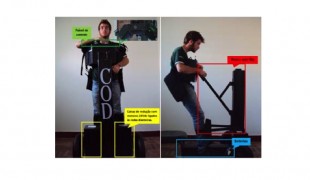- 5190
- 340
- 7
- 5
- 0
- Help Ukraine
About the solution
The mechanical engineer had studied prosthetics as an undergrad, but his physical therapy was a crash course in the biomechanics of walking. "That's when I realized that prosthetic feet were nothing like natural feet," he says.
With 26 bones, 35 joints, and the awesome responsibilities of weight-bearing and propulsion, the foot is one of the trickiest body parts to mimic. Today, amputees must choose between mechanical models, which rely on flat carbon-fiber platforms that bend slightly with each step, or a computer-controlled motorized foot that better reproduces a natural gait but can cost up to $18,000 and often isn't covered by insurance.
Working day and night in his cabin, in Boulder, Colorado, Rifkin built something that combined the natural step of a bionic foot with the simplicity and low cost of a mechanical prosthetic. His jointed foot has a heel, a forefoot, a big toe—and no joint at the ankle. Instead, a novel midfoot joint, which connects the heel and forefoot, does the job of both the ankle and the arch. Like an ankle joint, it flexes up and down to give the wearer a more natural step. And, like a real midfoot joint, it creates a flexible arch in the middle of the foot. A spring and cable connect it to a second joint at the toe, to create extra push-off at the end of each step. Other tensioned steel cables serve as the tendons and ligaments that govern its range of motion—the user doesn't control it, it simply responds to the pressure of walking. Because the front and back of the foot can move independently, it can react to uneven terrain.
More info: http://www.oandp.org/jpo/library/2010_02_113.asp
Adapted from: http://bit.ly/2hatoRN
What about you, do you have any solutions? Please share them with the Patient Innovation community!
This solution shall not include mention to the use of drugs, chemicals or biologicals (including food); invasive devices; offensive, commercial or inherently dangerous content. This solution was not medically validated. Proceed with caution! If you have any doubts, please consult with a health professional.
DISCLAIMER: This story was written by someone who is not the author of the solution, therefore please be advised that, although it was written with the utmost respect for the innovation and the innovator, there can be some incorrect statements. If you find any errors please contact the patient Innovation team via info@patient-innovation.com
-
-
443
-
0
-
5963

Man creates 3D printing arm for himself
-
-
-
544
-
0
-
7627

Dynamic Orthostatic Chair – A new locomotion method for disabled
WALKING WITH A WALKING AID: Walking with a walking aid
STANDING UP: Standing up from a seated position
WALKING: Walking
Cervical spinal cord injury/Tetraplegia
Walking Aid (wheelchair/walker/crutches)
Restoring mobility
Promoting self-management
To implement a diagnostic tool
Maintaining Balance and Mobility
General and Family Medicine
Neurology
Orthopedics
Pediatrics
Physical Medicine and Rehabilitation
Brazil
-
-
-
579
-
0
-
10331

Double amputee creates prosthesis for snowboarding and dancing
WALKING WITH A WALKING AID: Walking with a walking aid
Snowboarding
Dancing
Limb Amputation
Meningitis
Bacterial Infection
Prosthesis
Assistive Daily Life Device (to help ADL)
Difficulty walking or moving
Gait abnormalities (e.g., walking difficulties, unsteady gait)
Muscle weakness
Stiffness or rigidity (difficulty moving)
Limited range of motion
Recurrent fevers
Difficulty standing from a seated position
Difficulty fighting off infections
Changes in appetite or weight
Swelling or inflammation
Restoring mobility
Replacing lost limbs
Promoting inclusivity and social integration
General and Family Medicine
Infectious Diseases
Neurology
Orthopedics
United States
-
 en
en